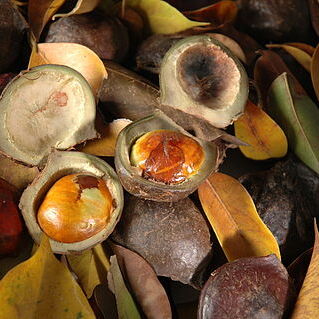Tree to 20 m high, up to 22 cm in diameter. Branchlets terete or slightly angular in the ultimate parts, greyish, scarcely puberulous, glabrescent, or glabrous. Leaves: rachis (or petiole) 0.5-3.5(-7) cm, usually with 2 glands, broadly elliptic to circular, raised, flat, 1-3 mm in diameter; pinnae 1 (or 2) pairs, 3—10(—13.3) cm, with circular glands, ± raised, flat, 0.5-1 mm in diameter; petiolules c. 3 mm, glabrous; leaflets 2-4 pairs per pinna, opposite or the proximal pair subopposite, chartaceous, base ± asymmetrically cuneate or rounded, apex acuminate to subcaudate, both surfaces glabrous, reticulation prominulous above, prominent beneath. Inflorescences either clustered at the old leaf-scars or terminal, scarcely puberulous or glabrous, consisting of pedunculate glomerules aggregated into panicles; glomerules, composed of (l-)2-4 subsessile flowers; floral bract ovate-elliptic, acute, c. 0.5 mm long. Calyx cup-shaped, 1.2-2.2 mm long, glabrous; teeth deltoid, 0.1-0.3 mm long. Corolla funnel-shaped, 4-5.5 mm long, glabrous; lobes ovate, acute, c. 1.2-3 mm long, sometimes reflexed. Stamens white, to c. 12 mm long, tube exceeding the corolla-tube. Ovary solitary, glabrous. Pod dark reddish or yellowish outside, reddish within, curved into a circle or spirally contorted, sinuate to submoniliform along ventral suture, chartaceous-coriaceous, up to c. 10 cm long, 0.7-1.5 cm wide over the seeds, down to 0.3 cm wide in between, glabrous, veins inconspicuous, dehiscing first along the ventral suture.
More
A tree. It grows 10-26 m tall. The leaves are compound and the leaflets are narrowly oval and 5-7 cm long by 3-4 cm wide. The pod is 9-12 cm long by 4-5 cm wide and often twisted. The seeds are flattened disks about 3 cm across. There are 5-7 seeds per pod. Some references confuse it with Archidendron jiringa eg Wikipedia

